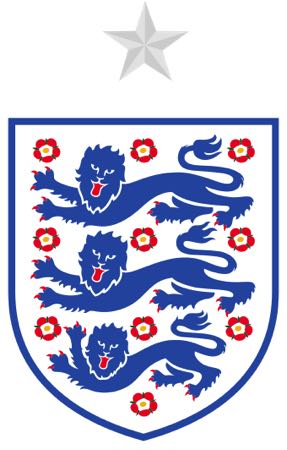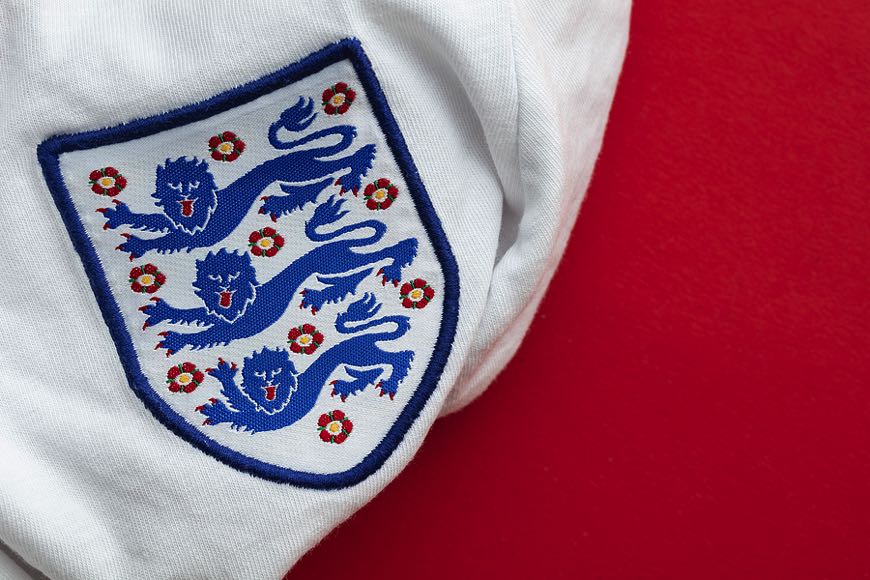Football teams have had nicknames from the earliest days of the sport and that applies to both club sides and national teams. Often there are very obvious reasons for a team being given a particular nickname, such as the rather unimaginative monikers like “The Reds”, “The Blues” and so on. But there are some more interesting nicknames kicking about (which we’ll explore in more detail later) including the England (men’s) national side’s nickname of the Three Lions (and the Three Lionesses for the women’s team).
There are three lions embroidered on the England badge, which inspired the football anthem Three Lions by David Badiel, Frank Skinner and the Lightning Seeds. But, why lions? It’s not like England has prides of Panthera leo roaming the moors and peaks of this green and pleasant land. Surely bulldogs would be more appropriate? Or maybe hedgehogs? Three squirrels, anyone? To solve the lion conundrum, we must take a trip back in time… to the 12th century no less, long before association football as we know it today even existed.
The Origins of the Three Lions
 According to The Guardian and various other sources, the three lions that have appeared on England shirts since their first match in 1872 date back to the 12th century. Specifically, banners carrying three lions were hoisted and carried into battle by Richard the Lionheart. But the first emblem with three lions actually appeared during the reign of Richard’s Father, Henry II, and quite possibly with earlier monarchs.
According to The Guardian and various other sources, the three lions that have appeared on England shirts since their first match in 1872 date back to the 12th century. Specifically, banners carrying three lions were hoisted and carried into battle by Richard the Lionheart. But the first emblem with three lions actually appeared during the reign of Richard’s Father, Henry II, and quite possibly with earlier monarchs.
Initially, Henry – who reigned from 1154 to 1189 – certainly had a coat of arms that included at least one lion and his son Richard is said to have developed this further to incorporate three lions on his royal seal. But should the lions actually be leopards?
The Three Leopards?
In heraldic history, there was often some ambiguity between leopards and lions (as the depictions were not necessarily that accurate). And, often the French translations of English terms (or vice versa) muddy the waters somewhat. Often in heraldry, when the image shows the animal rearing up, they are referred to as lions, but when they are walking or on all fours (as on the England football team’s badge), they were referred to as leopards. Though they were probably referred to as leopards initially, at some point in history, even those depicted on all fours began to be referred to as lions too (at least according to James Parker’s A Glossary of Terms Use in Heraldry, which is obviously on everyone’s bedside table at home).
Ultimately, we don’t want to make this a historical investigation into the artistic ambiguities of animals portrayed in royal banners. But the main point is that the three lions emblem began in the late 1100s and has been present on England shirts throughout the national side’s history. Quite simply, this is why England are called the Three Lions, the clue being in the song lyric “Three lions on a shirt”. In fact, the three lions emblem is actually the emblem of the English Football Association, the FA and was used for England’s very first international fixture against Scotland, way back in 1872.
National Team Nicknames: The Good, the Bad & the Downright Silly
Now we know why England are referred as the Three Lions, let’s take a quick look at some of the best and worst nicknames of other national football teams from around the globe.
| Country | Nickname | Nickname in English (If Different) | Notes |
|---|---|---|---|
| Germany | Die Mannschaft | The Team | Hmm, not many points for imagination from the Germans here, we’re afraid. |
| Gibraltar | Team 54 | Another that is rather literal in origin, Gibraltar were the 54th national side to be admitted to UEFA. | |
| Malta | Knights of St John | Like England’s nickname, Malta’s has historical significance and this harks back to the 7th century Catholic Military Order established in Malta. | |
| San Marino | La Serenissima | The Most Serene | Serenity is not an attribute usually associated with successful football teams, but then this is San Marino. Their nation is known as “The Most Serene Republic of San Marino”. |
| Colombia | Los Cafeteros | The Coffee Growers | Also known as The Tricolour (based on the three colours of their flag), this is the more interesting nickname and is inspired by the nation’s excellent coffee-growing prowess. Incidentally, the Colombia women’s team’s nickname is the Powderpuff Girls, named after a US cartoon series! |
| Bahamas | Rake and Scrape Boys | Rake and scrape (or rake n scrape) is a genre of music that is traditional in the Bahamas. | |
| Jamaica | Reggae Boyz | Another music-themed nickname for Jamaica as reggae started life on the island nation. | |
| Benin | Les Guépards (Current); Les Ecureuils (Former) | The Cheetahs; The Squirrels | Perhaps not as scary as facing three lions, but the idea here was to represent a small nation being able to rise up (like a squirrel climbing a tree…).
Obviously, this proved unpopular as the name then changed to Les Guépards, meaning The Cheetahs. |
| Cameroon | Lions Indomptables | Indomitable Lions | Not just lions, but indomitable lions no less! A suitable epithet for a team trying to portray strength and power. |
| Egypt | The Pharaohs | A nickname that stretches back much further than that of England’s as Egypt look to ancient times for their inspiration. | |
| Mauritius | Les Dodos | The Dodos | It seems strange to choose an extinct animal for your nickname, but the dodo once thrived on Mauritius, so why not? |
| Mozambique | Os Mambas | The Mambas | Being named after a poisonous snake is a little more like it. |
| Rwanda | Amavubi | The Wasps | Or, how about an insect with a real sting in its tale? |
| Jordan | The An-Nashama | The Brave Gentlemen | Given that “ungentlemanly conduct” on the football pitch can result in a booking, Jordan’s nickname plays into the ethos of the sport more than most. |
| Thailand | War Elephants | A herd of war elephants would be truly scary if you faced them on the battlefield. For most national teams though, facing Thailand on the pitch would not instil such fear. |




